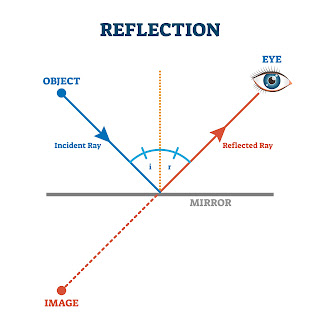

If you fix the view direction and change the direction of the incident ray in the middle even just slightly, then the observer will stop seeing the reflection of that ray. While the light beams intersect the surface at the same point on the surface, the observer will only see the reflection of the ray in the middle (the ray with the orange color). In figure 3, you can see the reflection of three rays with distinct incident directions and distinct colors.

R &=& I - \cos(\theta) * N - \cos(\theta) * N,\\įigure 3: the eye only "sees" the image of the object whose reflection direction coincidences with the view direction.Ī reflection of a light ray can only be seen if the reflected ray direction is traveling in the same direction as the view direction. We can write the second equation using this result as follows: We can re-write the first equation as follows: We can now replace \(B\) in both equations: It is the dot product between \(N\) and \(I\). The term \(\cos(\theta)\) is of course equal to: \(N.I\). As explained in the lesson on geometry, this can be computed using the following equation: It is the projection of the vector \(I\) or \(R\) onto the vector \(N\). As you can see in figure 2, the vectors I and R can be expressed in terms of the vectors A and B: Simple! This is called the law of reflection.Ĭomputing the reflection direction when the incident direction and the surface normal are known is very simple. In other words, if the angle between the incident direction and the surface normal is denoted \(\theta_i\) and the angle between the reflected direction and the surface normal is \(\theta_r\), then \(\theta_i = \theta_r\). It bounces back in a direction that is symmetrical to the incident direction about the surface normal at the point of impact as shown in figure 1\.

What happens to this photon, is very similar to what happens to a tennis ball when it hits the surface of the floor. Reflection is the result of what happens to a photon, or an incident light beam if you are not familiar with the concept of the photon, when it hits the surface of a reflective surface such as glass, water, or a sheet of aluminum for example. Let's start with reflection which is almost the simplest form of light-matter interaction. Figure 2: computing the reflection direction can be done using simple geometry. Reflection Figure 1: the angle of incidence and the angle of reflection are equal. In this chapter, we will learn about simulating reflection, refraction (transmission), and the Fresnel effect which defines for transparent materials such as glass and water how much light is reflected vs. Other materials are opaque and can not transmit any light though they can certainly reflect it very well. The important question we will need to answer in this chapter is how do we know how much light is transmitted versus how much light is reflected? To answer this question, we will need to learn about the Fresnel effect. Light can pass through them, a phenomenon we call transmission and they can reflect light at the same time. Glass or water are two very common materials that exhibit both properties. Reflection and refraction are very common in the real world and can be observed every day. Reflection, Refraction (Transmission), and Fresnel Reflection, Refraction and Fresnel Reading time: 29 mins. Normals, Vertex Normals and Facing Ratio.



 0 kommentar(er)
0 kommentar(er)
